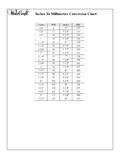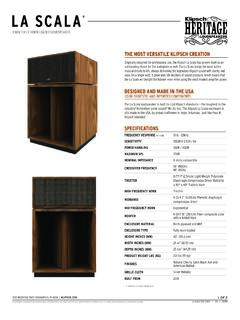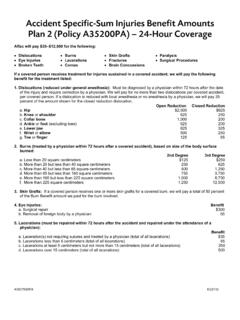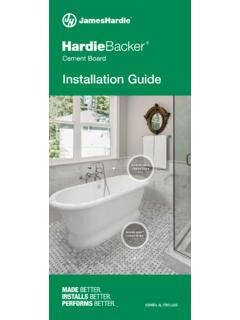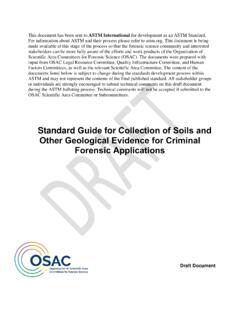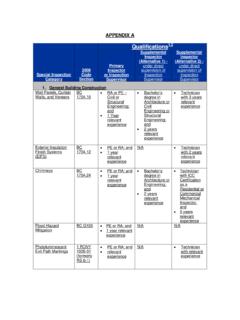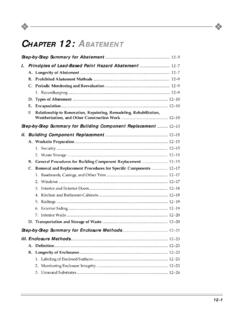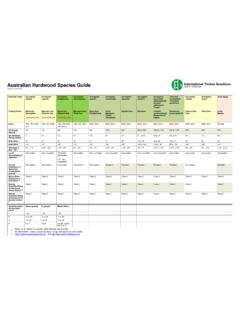Transcription of AP-42 CH 10.6.2 Particleboard Manufacturing
1 6/2002 Wood Products Particleboard General1,2 - Particleboard is defined as a panel product manufactured from lignocellulosic materials,primarily in the form of discrete particles, combined with a synthetic resin or other suitable binder andbonded together under heat and pressure. The primary difference between Particleboard and otherreconstituted wood products, such as waferboard, oriented strandboard, medium density fiberboard, andhardboard, is the material or particles used in its production. The major types of particles used tomanufacture Particleboard include wood shavings, flakes, wafers, chips, sawdust, strands, slivers, andwood wool. The term Particleboard sometimes is used generically to include waferboard and orientedstrandboard, which are manufactured primarily with wood flakes and wafers.
2 However, for the purposesof this report, Particleboard pertains only to panels manufactured from a mixture of wood particles orotherwise from wood particles other than wafers and flakes. Particleboard Manufacturing falls underStandard Industrial Classification (SIC) Code 2493, reconstituted wood products, which includeshardboard, insulation board, medium density fiberboard, waferboard and oriented strandboard in additionto Particleboard . The six-digit Source Classification Code (SCC) for Particleboard Manufacturing is 3-07-006. Process Description1,2 - Particleboard is produced in densities ranging from around 590 kilograms per cubic meter(kg/m3) (37 pounds per cubic foot [lb/ft3]) to greater than 800 kg/m3 (50 lb/ft3).
3 Most Particleboard isformed into panels. However, molded Particleboard products such as furniture parts, door skins, ormolded pallets are also some single-layer Particleboard is produced, Particleboard generally is manufactured inthree or five layers. The outer layers are referred to as the surface or face layers, and the inner layers aretermed the core layers. Face material generally is finer than core material. By altering the relativeproperties of the face and core layers, the bending strength and stiffness of the board can be general steps used to produce Particleboard include raw material procurement or generation,classifying by size, drying, blending with resin and sometimes wax, forming the resinated material into amat, hot pressing, and finishing.
4 Figure presents a process flow diagram for a typicalparticleboard furnish or raw material for Particleboard normally consists of wood particles, primarilywood chips, sawdust, and planer shavings. This material may be shipped to the facility or generatedonsite and stored until needed. In mills where chips are generated onsite, logs are debarked, sawn toproper length, and chipped. After shipping to the site or generation onsite, the furnish may be furtherreduced in size by means of hammermills, flakers, or refiners. After milling, the material is eitherscreened using vibrating or gyratory screens, or the particles are air-classified. The purpose of this stepis to remove the fines and to separate the core material from the surface material.
5 The screened orclassified material then is transported to storage the storage bins, the core and surface material are conveyed to dryers. Rotary dryers arethe most commonly used dryer type in the Particleboard industry. Both single and triple-pass dryers areused. In addition, some facilities use tube dryers to dry the furnish. Wood-fired dryers are used at mostfacilities. However, gas- and oil-fired dryers also are used. The moisture content of the particlesentering the dryers may be as high as 50 percent on a wet basis. Drying reduces the moisture content to2 to 8 percent. Dryer inlet temperatures may be as high as 871 C (1600 F) if the furnish is wet; for dryfurnish, inlet temperatures generally are no higher than 260 C (500 F).
6 Dryers with an inlet FACTORS2/2002moisture content of greater than 50 percent on a dry basis are labeled green dryers. A predryer may beused for initial drying of relatively wet furnish. Following predrying, the drying process is completed ina final dryer (which may be either a rotary dryer or a tube dryer). The dryer inlet temperature is adjustedbased on the desired furnish moisture content at the dryer outlet. Core dryers generally operate at highertemperatures than surface dryers due to differences in core and surface particle characteristics andbecause a lower moisture content is more desirable for core material. After drying, the particles pass through a primary cyclone for product recovery and then are transferred to holding bins.
7 Face material sometimes is screened to remove the fines, which tend toabsorb too much of the resin, prior to storage in the holding bins. From the holding bins, the core andsurface materials are transferred to blenders, in which the particles are mixed with resin, wax, and otheradditives by means of spray nozzles, tubes, or atomizers. Urea-formaldehyde is the resin most commonlyused for Particleboard manufacture. However, phenol-formaldehyde resin may be used for particleboardproduced for exterior are added to impart water resistance, increase the stability of the finished product underwet conditions, and to reduce the tendency for equipment plugging.
8 For furnishes that are low in acidity,catalysts also may be blended with the particles to accelerate the resin cure and to reduce the press scavengers also may be added in the blending step to reduce formaldehyde emissions fromthe generally are designed to discharge the resinated particles into a plenum over a beltconveyor that feeds the blended material to the forming machine, which deposits the resinated material inthe form of a continuous mat. Formers use air to convey the material, which is dropped or thrown into anair chamber above a moving caul, belt, or screen and floats down into position. To produce multilayerparticleboard, several forming heads can be used in series, or air currents can produce a gradation ofparticle sizes from face to it leaves the former, the mat may be prepressed prior to trimming andpressing.
9 The mats then are cut into desired lengths and conveyed to the press. The press applies heatand pressure to activate the resin and bond the fibers into a solid panel. Although some single-openingpresses are used, most domestic Particleboard plants are equipped with multi-opening batch presses. Total press time is generally minutes (min) for single-opening presses and up to 6 min for multi-opening presses. Continuous presses may also be used to produce Particleboard . Presses generally areheated using steam generated by an onsite boiler that burns wood residue. However, hot oil and hotwater also are used to heat the press. The operating temperature for Particleboard presses generallyranges from 149 to 182 C (300 to 360 F).
10 The presses used to manufacture molded Particleboard products are not platen presses, but arepress molds equipped with a heated die that shapes the resinated wood particles into the finished product. Press temperatures can range from 132 to 288 C (270 to 550 F). Press temperature and time varyaccording to the molded product being pressing, the boards generally are cooled prior to stacking. The Particleboard panels thenare sanded and trimmed to final dimensions, any other finishing operations (including laminate or veneerapplication) are done, and the finished product is packaged for Products (SCC 3-07-006-64)CoreMaterialStorageCooling(S CC 3-07-006-61)Sanding(SCC 3-07-006-65)TrimmingOtherFinishingOperat ionsDrying(SCC 3-07-006-02 to -40)Drying(SCC 3-07-006-02 to -40)CycloneScreeningSurfaceMaterialStora geCycloneCoreMaterialStorageBlendingForm ingBlendingResin, waxother additivesPrepressingTrimmingHeat, pressurePressing(SCC 3-07-006-51, -55)











